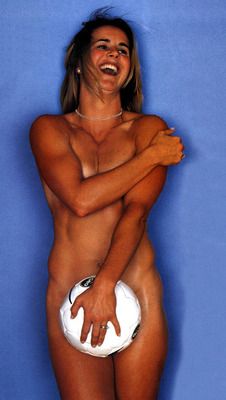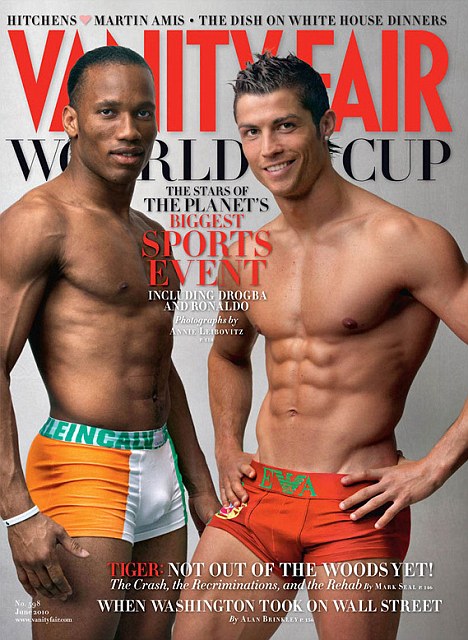What sells women’s soccer?
The 2015 Women’s World Cup is kicks off tomorrow, with games in six cities across Canada. If previous tournaments are any indication, American women’s soccer will receive an unprecedented amount of media coverage. Fox Sports will be airing many of the games live, and Fox has engaged in high levels of promotion, from commercials to social media hashtags to player appearances on American Idol and The Simpsons. This is an enormous positive for women’s soccer in the U.S., bringing cultural recognition not only to the stars of the National Team but to a professional league (The National Women’s Soccer League) plagued by a lack of national visibility.
As scholars of gender, sport, and media have shown, however, it is not just in the quantity of media coverage that women’s elite sports typically suffer. Quality matters, too. When female athletes receive attention from mainstream mass media, the coverage often presents stereotypical depictions that undermine athletic competence in service of norms of heterosexual femininity. Sexualized imagery is pervasive here, whether the hypersexual availability of the “sex kitten” or the wholesome suggestiveness of the “girl next door.”
Women’s soccer is no stranger to this type of trivializing media coverage. The 1999 U.S. Women’s National Team, the so-called “Girls of Summer,” embarked on a post-tournament media tour where their purported heterosexuality and femininity were highlighted as much as their victories on the field. Brandi Chastain became a household name not only for her game-winning penalty kick in the tournament’s finale, but for her appearances in men’s magazines. As scholar Helen Shugart concludes, images of the team constructed them as “appropriately feminine and unthreatening.”

Of course, men sometimes, and perhaps increasingly, receive similar treatment. For instance, do you remember the underwear clad image of men’s soccer stars on the cover of Vanity Fair prior to the 2010 men’s World Cup? Still, this cover was only one of many images we saw of that tournament’s players. Sexualized images of female athletes exist in a context of far fewer images overall, meaning that those we do see tend to shape our perceptions of these athletes and the sports they play far more.

And of course, from the vantage point of individual players, this route towards greater visibility and sponsor buy-in makes a lot of sense. In a world where professional sports exist as part of a corporatized, commercialized entertainment field, sexuality is a way to stand out, to self-promote, to celebritize. These images exist not only in a context of media silence on women’s sport, but also major pay inequities that often push female athletes towards second jobs, reducing the time they have to devote to their sport. It’s no surprise to me, then, to see sexualized images promoted by female athletes themselves on social media sites like Twitter and Instagram.
My own study of U.S. women’s professional soccer, which involved the collection of participant observation, interview, and media data between 2011 and 2012, shows that in contrast to depictions in mainstream mass media, few though they were, internal league depictions of the players rarely contained overt sexualization. Instead, players were almost always depicted in uniform and in action, highlighting skill on the field over any qualities external to the game.

Seeing the vastly difference forms of visual coverage of women’s soccer players produced by this league, compared to mainstream mass media outlets, it is easy to presume a rejection of the sexualization strategy on the part of women’s soccer insiders. Yet my research shows that the perspectives of those working to sell women’s soccer were somewhat more complex.
Take Jordan, for instance. Jordan was a young manager with one women’s professional team. In my interview with her, she told me that a player had joked to her that if the games were played in sports bras, more fans would show up. Jordan laughed while telling this story, and said about the proposition,
No, it will never happen. I mean you can’t. You can’t! Sex sells, we have sexy players. But we’ll never choose to display our players as sexual objects. I mean, it would boost attendance! But it’s a joke. It’s not respectable.
Jordan felt that while (hetero)sexualized imagery could be effective in drawing fans, it simultaneously compromised the legitimacy of a fully professional women’s sports league. Similarly, league staff member Joseph argued that while sexualized imagery could bring needed attention to the women’s game, the league itself was hesitant to risk the perceived “professionalism” of its players. Joseph commented,
We [the team] came at it to portray these women as professional athletes. You try to treat them like it’s any other professional sport. And if they do things on the side, like the swimsuit issue that Alex [Morgan] did or do photo shoots or fashion shows, that’s awesome and that will bring more people to the game. Whether you’re selling a hot dog or you’re selling tennis shoes, if you look on TV, sex sells. Am I a fan of it? No. First and foremost they are female athletes, they’re professional athletes in general.
So although the men and women working for the league did not, with few exceptions, produce this kind of image, they sometimes wished that they could do that, given a strong belief in the effectiveness of “heterosexy” images in garnering attention. This feeling emerged most clearly in discussions of the league’s struggles against mass media invisibility and low levels of fan attendance and engagement. For example, staff member Raymond framed sexualization as a potentially necessary evil, making the case that,
When you see these players play, you can’t help but realize that they’re really good athletes, especially at that level. And hey, if it takes somebody to see Alex Morgan in a bikini to get them to go to the game…You do what you need to do.
After an extensive discussion of the lack of television exposure for this women’s league, I asked Cherish what she felt women’s pro soccer could do to increase its profile. In response, she argued,
You need a female David [Beckham]. Somebody that’s just amazing and also could be a model. Tough situation, and is it right? Is that fair? Is it correct? I don’t know. All I do know is that I think it would work as well as anything.
Those working for women’s soccer see that while sexualized imagery may draw eyeballs in the short term, it does little to build a lasting audience for women’s soccer, one that respects and admires the athleticism and dedication of the women who pursue professional careers. Despite the pervasiveness of the “sex sells” rhetoric, recent research shows that sexualization tends to undermine support, rather than build it. As Mary Jo Kane, director of the Tucker Center for Research on Girls and Women in Sport, writes, “Sex sells sex. Not women’s sports.” Fortunately, what does sell women’s sports is exactly what we will see in just a few short weeks – talent, skill, and teamwork at the highest level.
Rachel Allison is in the Sociology department at Mississippi State University.

Comments 4
Matt
June 5, 2015Good post, Rachel. Mary Jo Kane's piece has been effective in the classroom for me, but I was wondering about your thoughts about another possible counter-example. Is there any data available for the attendance levels of the Lingerie Football League? It seems that if sex really sold sport -- like some suggest -- they would have a lot higher of a media profile than they currently enjoy. I think that your work and the work you reference here -- among other things -- does a good job of demonstrating the complexities of the relationships between "sex," "gender," and professional soccer.
Andy
June 5, 2015The attendance at the Lingerie Football League games near Chicago (The Chicago Bliss) is very low. They have about 3 home games per spring/summer with a couple of thousand people in attendance per game. Why don't they have more home games? Because attendance is very low. The WNBA team here (Chicago Sky) is seeing a significant increase in home game attendance with Elena Delle Donne. Their marketing doesn't sex her up at all. She is tall and gawky and all of the images of her on social media are rated PG. Focusing on her athletic skill is working for The Sky in terms of attendance.
Tom Lino
June 7, 2015The WWE pro wrestling has The Divas clad in revealing outfits. Thought a professional sport it's not, they work hard and are in excellent physical condition. I'm sure it helps gain media attention.
Marisa
July 1, 2015Football sports activities information and updates portals; TV channels and the print media are
incomes excessive earnings from sports activities reporting.
They are casting their one-eyed gaze at locals and tourists from statues,
posters and a good deal of Olympic merchandise that varies
from key chains to cutlery. The leather ball was created from
several spherical roots by means of hard bristles
that had been coated with rawhide, but once again, the
game was played passing the ball from hand at hand.